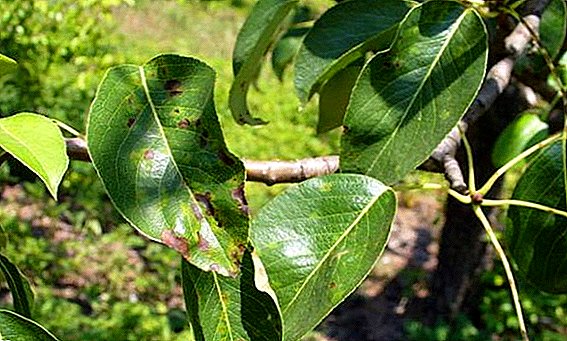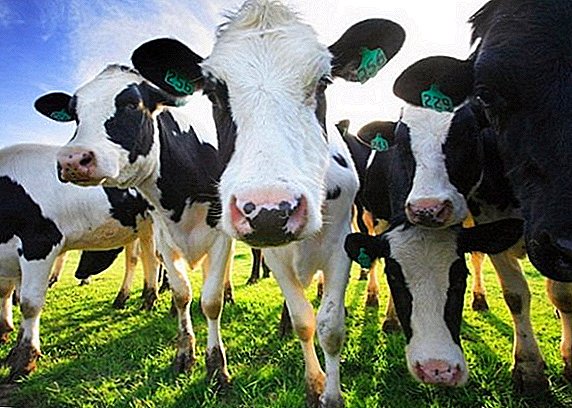 The defeat of bovine bluetooth occurs less frequently than in sheep. This disease, originally from Africa, is increasingly recorded in cows in European countries. We learn what kind of disease it is, how it is dangerous for an animal, how to treat it and what are the preventive measures.
The defeat of bovine bluetooth occurs less frequently than in sheep. This disease, originally from Africa, is increasingly recorded in cows in European countries. We learn what kind of disease it is, how it is dangerous for an animal, how to treat it and what are the preventive measures.
What a disease
Blutang is also called catarral fever or "blue tongue". This is a viral infection in which arthropods are involved. When it is observed inflammatory necrotic lesions of the oral cavity, gastrointestinal tract, skin epithelium of the hoof.
Did you know? The first time bluesing was discovered in southern Africa in 1876 and was originally considered an African problem. Now this disease of livestock is spread on almost all continents. Outbreaks of this disease have recently been reported in many European countries.
Pathogen, sources and routes of infection
Blutang is caused by an RNA-containing virus from the Orbivirus genus (family Reoviridae). The disease is both single and widespread. Its source is sick animals. Biting midges of the genus Culicoides are involved in the transmission of this viral infection.
This gives it a stationary nature and makes it dependent on the seasons. The disease usually occurs in the summer and is most actively spread on hot days. Most often it is recorded in swampy areas or in areas characterized by a large amount of annual precipitation and water stagnation.
This disease is more susceptible to malnourished animals suffering from worms and infections. Risk factors for occurrence are also crowded animals and sunlight.  Carrier of viral infection - woodlouse
Carrier of viral infection - woodlouse
Incubation period and signs
Blutang is characterized by an incubation period of 6-9 days and can occur in different forms (acute, subacute, chronic, abortive).
In the acute form of the disease, the following symptoms are observed:
- increased temperature (+ 41-42 ° C), which lasts from 2 to 11 days;
- redness, erosion, and ulcers of the mucous membranes of the mouth;
- increased salivation;
- the smell of rot from the mouth;
- purulent nasal discharge;
- swelling of the ears, lips, tongue, jaw, which gradually engulfs the neck and chest;
- over time, the tongue becomes crimson or bluish shades, it may hang (not always);
- poddermatit;
- lameness and curvature of the neck;
- in advanced cases, there are diarrhea with bloody patches, large weight loss and weakness.
Anaplasmosis, pasteurellosis, actinomycosis, abscess and parainfluenza-3 are also referred to as infectious diseases of cattle.
The acute form of the disease usually takes 6–20 days and can be fatal for an animal 2–8 days after the first signs are detected. In subacute or chronic forms of the disease, all of the above symptoms appear slowly and are not very pronounced.  With this course of the disease, the animal has a loss of weight, a poor quality of coat, and a lesion on the limbs leading to lameness. On the background of a sluggish disease, bronchitis, pneumonia and other secondary infectious diseases may appear.
With this course of the disease, the animal has a loss of weight, a poor quality of coat, and a lesion on the limbs leading to lameness. On the background of a sluggish disease, bronchitis, pneumonia and other secondary infectious diseases may appear.
Did you know? A total of 24 bluetongue serogroups were identified. Vaccines against this disease usually include 4 common strains of the causative virus. The Republic of South Africa has a vaccine containing 14 serotypes of this disease.
The subacute form can last about 30-40 days, and the chronic bothers for more than a year. An animal with this course of the disease gradually recovers, but death is not uncommon, especially in places where bluetang appeared for the first time.  The abortive form is characterized by a slightly increased temperature, a slight lesion of the mucous membranes, although necrotic changes can sometimes be observed in the oral cavity. Cows have a depressed state and a drop in milk production.
The abortive form is characterized by a slightly increased temperature, a slight lesion of the mucous membranes, although necrotic changes can sometimes be observed in the oral cavity. Cows have a depressed state and a drop in milk production.
Usually such signs can be seen if vaccination has been carried out, and the condition of the animal as a whole is quite satisfactory. Pregnant cows can have a miscarriage or give birth to inferior offspring. The most dangerous for the embryo infection in the first three months of pregnancy.
Laboratory diagnosis
Since the clinical signs of bluetongue do not always appear, laboratory blood tests should be performed for livestock brought into the farm. This is very important, since for areas where this disease has never been observed, the death of the herd may amount to about 90% of the total population.
The pathogen virus is secreted by serological methods. The most frequently used for the diagnosis of enzyme immunoassay, which accurately detects antibodies to bluetongue.
We advise you to read about how to choose the right cow, how to feed a milch and dry cow, how to measure the body temperature of cows, how to wean the cow butting, how to properly feed the cows on pasture, and find out what the weight of cattle depends on.
An animal that has already recovered retains such antibodies for a long time, so this study will not show the full picture in the outbreak areas of the disease. But it is quite suitable for identifying disadvantaged cows to be imported into the country or into farms.
For diagnostic purposes, they can use polymerase chain reaction, which allows to isolate the serogroup and give the most accurate results.  Blood sampling for laboratory diagnosis
Blood sampling for laboratory diagnosis
Pathological changes
When catarrhal fever cattle observed the following pathological changes:
- severe exhaustion of the whole organism;
- poor circulation, which causes swelling of the lower body;
- inflammation of the mucous membranes, which have a bluish tint;
- increase and cyanosis of the tongue, which often falls outside;
- gums and internal cavities of cheeks are affected by erosion, as well as ulcers;
- the musculature of the skeletal part has multiple foci of tissue death;
- the heart muscle is enlarged and has a loose structure;
- changes in the structure of internal organs;
- dropsy is often detected;
- dystrophic changes in the vascular endothelium, gastrointestinal mucosa and skeletal muscles.
Is it possible to cure
Unfortunately, there is currently no effective treatment for cattle against bluetongue. Treatment is more concerned with preventive measures. An important point is vaccination. Sick animals are given for slaughter. 
Immunity
An animal that has had catarrhal fever develops lifelong immunity to this virus serogroup. Corresponding antibodies appear in the blood that can be transmitted to the young when fed with colostrum. To develop immunity against this disease, a vaccine containing several strains is used.
It is administered to animals under the skin in a volume of 1-2 ml. The development of immunity occurs after 10 days and lasts more than a year. During the vaccination period, cattle should be protected from the active sun. Vaccination is carried out on animals from three months of age.
Important! Calves and lambs are recommended to feed from the vaccinated mom and not artificial substitutes, as they develop immunity to bluetongue, which lasts for 3-4 months.
Rules for the prevention and control of bluetooth
Such a disease is better to prevent than to cure. The main prevention against it is, as mentioned above, the timely vaccination against the disease.  Disinfection of the barn, as a method for the prevention of bluetongue
Disinfection of the barn, as a method for the prevention of bluetongue
To prevent the spread of infection, you should adhere to the following recommendations:
- use insecticides and repellents;
- Do not walk the herd in swampy areas;
- keep cattle in specialized barns all year round;
- when purchasing a new livestock, observe a certain time quarantine;
- conduct serological diagnostics with a time interval of 20 days;
- control the quality of purchased sperm for fertilization;
- do not keep cattle and sheep in the same breeding room;
- make regular prophylactic vaccinations, especially 30 days before the appearance of blood-sucking pests (midges, mosquitoes, ticks and others);
- conduct regular general examinations, take blood tests for timely detection of diseases;
- observe hygienic rules and carry out constant disinfection.
If, nevertheless, the disease is detected and the tests have shown a positive result, then the entire farm moves to quarantine, and the terrain within a radius of 150 km is considered to be unfavorable. This is due to the transmission of infection by mosquitoes, flies and other insects.
Important! Meat after slaughter can be consumed only after cooking for at least 2.5 hours, so often such meat goes for the production of canned food or sausage.In the zone of possible spread in animals, blood samples are selectively taken and examination is carried out to identify the disease in cattle. In the quarantine zone, the import and export of animals is prohibited. Sick individuals are given for slaughter.
 Conducting vaccination of cattle, as a method for the prevention of bluetongue
Conducting vaccination of cattle, as a method for the prevention of bluetongueQuarantine is canceled only one year from the last recorded case of the disease and with normal results when taking tests for the presence of the causative agent. But diagnostics and vaccinations are carried out constantly in this zone and the territories nearest to it.
Blutang is a rare cow disease in our territory, but outbreaks of this disease are often recorded in Europe and have reached our territory. Purchased animals from other countries should be checked and vaccinations should be carried out if cases of this disease have been recorded somewhere near or on the farm.












